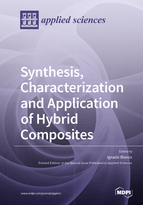Synthesis, Characterization and Application of Hybrid Composites
A special issue of Applied Sciences (ISSN 2076-3417). This special issue belongs to the section "Chemical and Molecular Sciences".
Deadline for manuscript submissions: closed (31 May 2020) | Viewed by 44235
Special Issue Editor
Interests: materials; polymers; thermal properties; nanocomposites; composites
Special Issues, Collections and Topics in MDPI journals
Special Issue Information
Dear Colleagues,
Polymer composites represent the platform materials of the XXI century and are an important slice of the market in the production of modern plastics. Their design is based on adding a second component to the polymer matrix to enhance its properties. Among the various possible composites, organic–inorganic hybrid materials offer advantageous performance relative to either of the non-hybrid counterparts. The dramatic improvement of physical properties, compared with pure materials, in which inorganic particles or nanoparticles are inserted into an organic polymeric matrix, could bridge the gap between ceramics and polymers. We are interested in articles that explore polymer-based hybrid systems. Potential topics include, but are not limited to, the following:
- The synthesis and characterization of polymeric hybrid materials
- Hybrid composites in electronics and energy applications
- Hybrid composites in space applications
- The biomedical application of hybrid polymeric materials
Prof. Dr. Ignazio Blanco
Guest Editor
Manuscript Submission Information
Manuscripts should be submitted online at www.mdpi.com by registering and logging in to this website. Once you are registered, click here to go to the submission form. Manuscripts can be submitted until the deadline. All submissions that pass pre-check are peer-reviewed. Accepted papers will be published continuously in the journal (as soon as accepted) and will be listed together on the special issue website. Research articles, review articles as well as short communications are invited. For planned papers, a title and short abstract (about 100 words) can be sent to the Editorial Office for announcement on this website.
Submitted manuscripts should not have been published previously, nor be under consideration for publication elsewhere (except conference proceedings papers). All manuscripts are thoroughly refereed through a single-blind peer-review process. A guide for authors and other relevant information for submission of manuscripts is available on the Instructions for Authors page. Applied Sciences is an international peer-reviewed open access semimonthly journal published by MDPI.
Please visit the Instructions for Authors page before submitting a manuscript. The Article Processing Charge (APC) for publication in this open access journal is 2400 CHF (Swiss Francs). Submitted papers should be well formatted and use good English. Authors may use MDPI's English editing service prior to publication or during author revisions.
Keywords
- Composites
- Nano-composites
- Polymer blends
- Polymer hybrid
- Biomimetic materials
- Biopolymer






